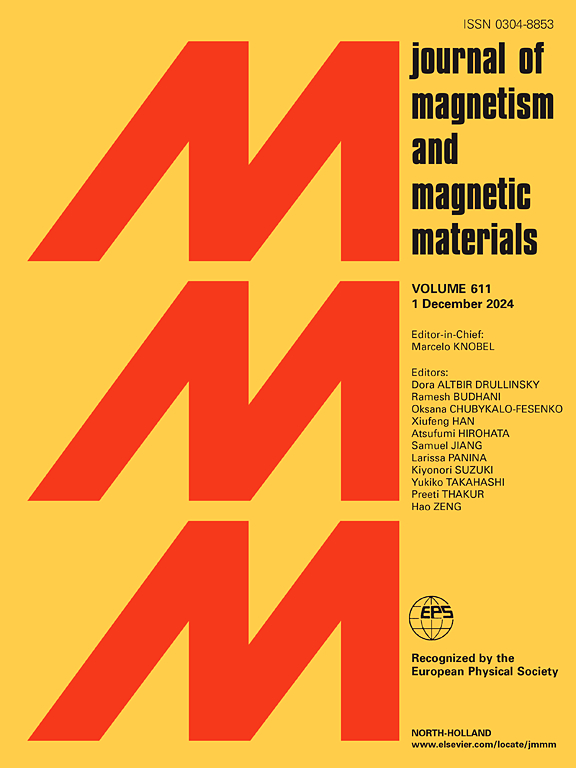扶手椅石墨烯纳米带自旋塞贝克效应的机电控制
IF 2.5
3区 材料科学
Q3 MATERIALS SCIENCE, MULTIDISCIPLINARY
引用次数: 0
摘要
本研究研究了扭曲扶手椅型石墨烯纳米带(TAGNRs)周期性结构的电子和热电特性。我们考虑了基于N二聚体链的三种不同宽度的tagnr (N=3p+q,其中q=mod (N,3)),有和没有空位缺陷。在理想的tagnr中,通过增加扭转系数,在低扭转状态下,q=1时带隙减小,q=2和q=0时带隙显著增大,类似于这些结构中的局部扭转。当引入空位缺陷时,平均场Hubbard模型预测在所有类别的tagnr中都存在自旋半导体效应。通过调整扭曲效应和纳米带的宽度,在有缺陷的tagnr中观察到巨大的自旋塞贝克系数(SSC)。通常,SSC值和自旋电流与扭转系数、空位缺陷的位置和纳米带的宽度密切相关。最后,在存在空位缺陷的情况下,AGNRs的机电行为会影响其热电性能,尤其是SSC。本文章由计算机程序翻译,如有差异,请以英文原文为准。
Electromechanical control of spin-Seebeck effects in armchair graphene nanoribbons
This study investigates the electronic and thermoelectric properties of a periodic structure of twisted armchair graphene nanoribbons (TAGNRs). We consider three different widths for TAGNRs based on N dimer chains (N=3p+q, where q=mod (N,3)) with and without vacancy defects. In ideal TAGNRs, by increasing the torsion coefficient, the bandgap decreases for q=1 and significantly increases for q=2 and q=0 in the low torsion regime, similar to local twists in these structures. When introducing vacancy defects, the mean field Hubbard model predicts a spin-semiconducting effect in all classes of TAGNRs. A giant spin Seebeck coefficient (SSC) is observed with a large bandgap in defected TAGNRs by tuning the twisting effect and the width of the nanoribbon. Generally, the SSC value and spin currents strongly depend on the torsion coefficient, the location of vacancy defects, and the width of the nanoribbon. Finally, the electromechanical behavior of AGNRs can manipulate the thermoelectric properties especially the SSC in the presence of vacancy defects.
求助全文
通过发布文献求助,成功后即可免费获取论文全文。
去求助
来源期刊

Journal of Magnetism and Magnetic Materials
物理-材料科学:综合
CiteScore
5.30
自引率
11.10%
发文量
1149
审稿时长
59 days
期刊介绍:
The Journal of Magnetism and Magnetic Materials provides an important forum for the disclosure and discussion of original contributions covering the whole spectrum of topics, from basic magnetism to the technology and applications of magnetic materials. The journal encourages greater interaction between the basic and applied sub-disciplines of magnetism with comprehensive review articles, in addition to full-length contributions. In addition, other categories of contributions are welcome, including Critical Focused issues, Current Perspectives and Outreach to the General Public.
Main Categories:
Full-length articles:
Technically original research documents that report results of value to the communities that comprise the journal audience. The link between chemical, structural and microstructural properties on the one hand and magnetic properties on the other hand are encouraged.
In addition to general topics covering all areas of magnetism and magnetic materials, the full-length articles also include three sub-sections, focusing on Nanomagnetism, Spintronics and Applications.
The sub-section on Nanomagnetism contains articles on magnetic nanoparticles, nanowires, thin films, 2D materials and other nanoscale magnetic materials and their applications.
The sub-section on Spintronics contains articles on magnetoresistance, magnetoimpedance, magneto-optical phenomena, Micro-Electro-Mechanical Systems (MEMS), and other topics related to spin current control and magneto-transport phenomena. The sub-section on Applications display papers that focus on applications of magnetic materials. The applications need to show a connection to magnetism.
Review articles:
Review articles organize, clarify, and summarize existing major works in the areas covered by the Journal and provide comprehensive citations to the full spectrum of relevant literature.
 求助内容:
求助内容: 应助结果提醒方式:
应助结果提醒方式:


